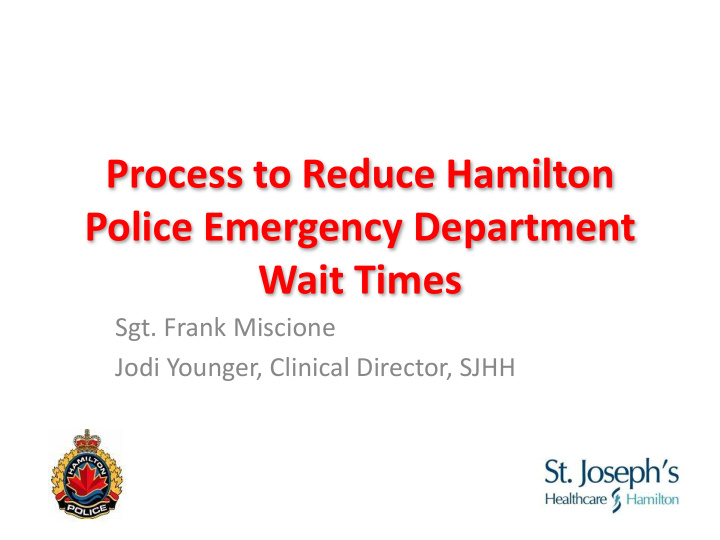



Process to Reduce Hamilton Police Emergency Department Wait Times Sgt. Frank Miscione Jodi Younger, Clinical Director, SJHH
August 2005 2
The Problem • 2011: study commissioned by Chief Glenn De Caire (2008-2010) • Police were waiting 122 min. average & 240 min. @ 90 th percentile • April 2011 to March 2012: 1591 persons were brought to St. Joes • Total SJHH ED volume 2012-2013: 60314 • Total PES cases 2012-2013: 7838 (13% total ED)
The Problem From the Hospital Perspective: • Perceived stigma • Crowded clinical spaces • Privacy concerns
The Problem • Lack of standardization for risk assessment & reporting • Lack of appropriate work space for police • Inaccurate understanding of the Mental Health Act. • Tension & conflict between nursing staff and police officers
The Solution • Working Group – co-chaired by hospital & HPS – Decision-makers & knowledge-brokers from front- line and management • Defined problem and approach in work plan • Rapid change/lean methodology approach • Actively reporting to Chief of Police and President, SJHH
The Solution • Process Review of current “ with police ” process • Small tests of change to reduce waste (e.g. “ with police tag ” ) • Legal review of requirements under the MH Act for clear go forward decision • A new process & communication form was developed.
The Solution APPREHENSION, BRING TO HOSPITAL TRIAGE TO ED OR PES Arrive ¡at ¡St ¡Joseph’s ¡Hospital. ¡. OBSERVATION PERIOD & EDP/COMMUNICATION FORM HIGH RISK – OFFICER STAYS MD ASSESSMENT – OFFICER LEAVES MEDIUM OR LOW RISK – OFFICER & HOSPITAL COLLABORATE ON DECISION OFFICER LEAVES PATIENT IN CARE OF HOSPITAL
Main Change • Kaizen event with review @ 1 wk, 4 wks and 8 wks. (July 22, 2012 – October 1, 2012) – Introduction of observation form – Intense training & orientation on new process – 24-7 on call and on site support for first week – Problem resolution process via working group
Police Observation LOS RESULTS 900 800 700 Wait Time LOS in minutes 600 500 Average (81.8 400 min) 300 200 90th Percentile (137.8 min) 100 0 10-Jul 30-Jul 19-Aug 8-Sep 28-Sep 18-Oct 7-Nov Time Period
Outcomes July-Oct 2012 • average wait time dropped from 125 minutes to 81.8 minutes • 90 th percentile wait time dropped from ~240 minutes to 137.8 minutes – 59% of the time police are released in 60 minutes or less. – 80% of the time police are released in 90 minutes or less. – 89% of the time police are released in 120 minutes or less.
Police Officers Average Wait Times by Risk Category in the Emergency Department SJHH October 2012 - January 2014 160 138 136 140 118 120 108 106 106 100 99 97 100 95 94 91 88 87 86 85 Minutes 83 83 82 80 79 78 77 77 80 75 75 75 74 74 73 73 73 73 72 72 71 70 70 69 68 68 68 68 68 66 65 65 64 64 64 61 61 60 60 60 60 55 55 54 49 47 41 38 40 35 20 0 0 Oct/12 Nov/12 Dec/12 Jan/13 Feb/13 Mar/13 Apr/13 May/13 Jun/13 Jul/13 Aug/13 Sept/13 Oct/13 Nov/13 Dec/13 Jan/14 High Med Low Unidentified x̄ ¡ = 74
Outcomes • Prior mean wait: 122 minutes • Current mean wait: 74 minutes Trending down snapshots: 82 min 77 min 74 min • Prior 90 th percentile wait: 240 minutes • Current 90 th percentile wait: 125 minutes
Next Steps • Ensure form completion is happening • Ensure that wait times for officers who need to stay are still monitored (still want to minimize wait) • Continue to look for opportunities to refine the process and get to the 60 minute target • MOU to finalize expectations
Important Elements • Standing working group to stay connected & monitor • On the ground leaders/managers need to continue to actively monitor the process until it is “ burned in ” to reduce the risk of sliding back to old behaviour. • Actively solicit feedback from the front-line • Open lines of communication between police and ED leadership to report problems from both sides and then the leaders must follow up to investigate the problem and provide the necessary resolution. • Ensure you end the pilot at some point – commit to a final product.
Contact Jodi Younger younger@stjoes.ca Frank Miscione FMiscione@hamiltonpolice.on.ca
Recommend
More recommend